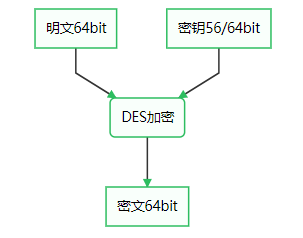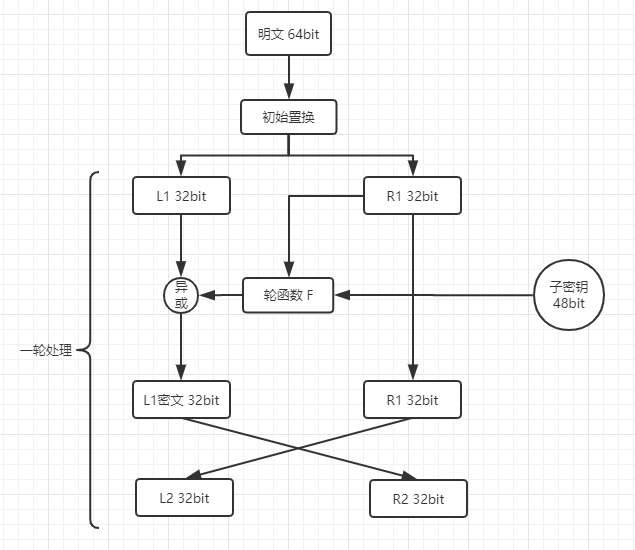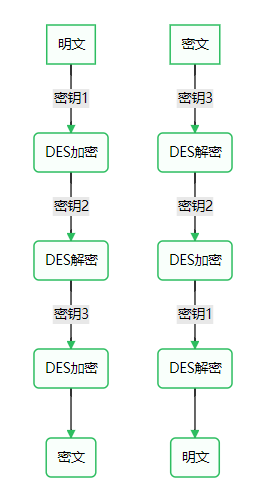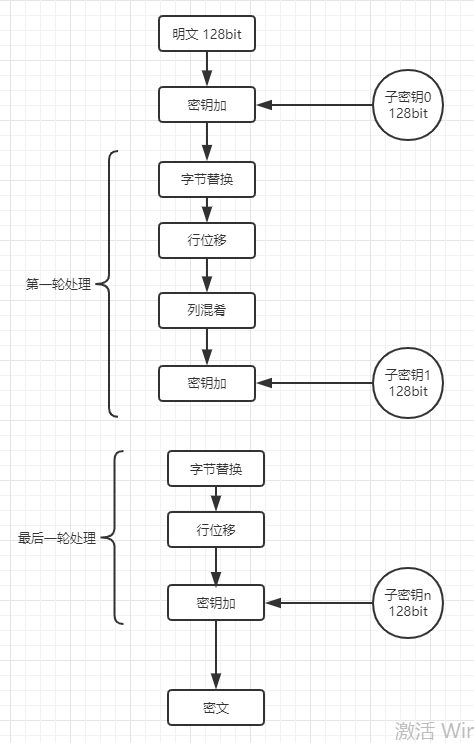密码学系列 - 对称加密
- bobgojoe
- 发布于 2020-03-26 12:07
- 阅读 4541
密码学很神秘?很高端?本文是密码学系列第二篇:对称加密 对称加密算法主要包括 DES、3DES、AES
密码学系列 - 对称加密
本文讨论的对称加密算法主要包括 DES、3DES、AES
DES
明文:64 bit 密文:64 bit 密钥:56/64 bit(每 7 位插入一个校验位的时候为 64 bit) 其设计思想充分体现了香农提出的混淆和扩散原则

DES 使用的是 Feistel 结构来加密的,一共需要 16 轮,加密过程如下:
- 将明文进行初始置换(通过置换表)
- 将置换后的数据分为左右 L1 R1 各 32 bit
- 将 48 bit 的子密钥与 R1 作为轮函数F的输入
- 将 L1 与轮函数的输出异或运算,得到 L1密文
- 将 L1 密文与 R1 交换位置,分别作为下一轮的 R2,L2
- 将 2-5 再重复 15 次
- 将 L17 R17 交换位置,并拼接为 64bit 数据
- 将 64bit 数据进行逆初始置换,得到最终密文
需要注意的是:
- 子密钥在每一轮中都是不一样的
- 每一轮之间会将左侧和右侧对调(右侧没有加密)
- 解密的过程就是将输出用相同的子密钥再走一遍,如果加密的子密钥顺序是key1 key2 key3,则解密的子密钥为key3 key2 key1
- 轮函数可以设计为不可逆函数如hash,对解密没有影响

golang 代码实战:
func TestDesEncrypt(t *testing.T) {
key:=[]byte{0x01,0x01,0x01,0x01,0x01,0x01,0x01,0x01}
cipherBlock,err:=des.NewCipher(key)
if err!=nil{
t.Error(err)
}
src:=[]byte{0x01,0x02,0x03,0x04,0x05,0x06,0x07,0x08}
encrptDst :=make([]byte,len(src))
cipherBlock.Encrypt(encrptDst,src)
t.Log(encrptDst)
plainDst:=make([]byte,len(encrptDst))
cipherBlock.Decrypt(plainDst, encrptDst)
t.Log(plainDst)
}
//out: [206 173 55 61 184 14 171 248]
//out: [1 2 3 4 5 6 7 8]三重DES
明文:64 bit 密文:64 bit 密钥:56/64 * 3 bit(加入校验位的时候为64 bit)
为了增加 DES 的强度,明文经过 3 次 DES 处理后变成最后的密文,因此密钥长度为 56/64 * 3 bit。3 次 DES 处理并不是简单的 3 次加密的过程,而是加密、解密、加密,解密的过程相应的就是解密、解密、解密。这样设计是因为在 3 个密钥相同时,可以兼容 DES 算法

golang 代码实战:
func TestTripleDesEncrypt(t *testing.T) {
key:=[]byte{0x01,0x01,0x01,0x01,0x01,0x01,0x01,0x01,0x01,0x01,0x01,0x01,0x01,0x01,
0x01,0x01,0x01,0x01,0x01,0x01,0x01,0x01,0x01,0x01}
cipherBlock,err:=des.NewTripleDESCipher(key)
if err!=nil{
t.Error(err)
}
src:=[]byte{0x01,0x02,0x03,0x04,0x05,0x06,0x07,0x08}
encrptDst :=make([]byte,len(src))
cipherBlock.Encrypt(encrptDst,src)
t.Log(encrptDst)
plainDst:=make([]byte,len(encrptDst))
cipherBlock.Decrypt(plainDst, encrptDst)
t.Log(plainDst)
}
//此处3个密钥相同,兼容DES
//out: [206 173 55 61 184 14 171 248]
//out: [1 2 3 4 5 6 7 8]AES
明文:128 bit 密文:128 bit 密钥:128/192/256 bit (分别需要10/12/14轮)
AES 标准最后评选出的算法是 Rijindale 算法,该算法支持密钥 128/192/256 bit ,分别需要 10/12/14 轮,本文讨论的是 128 bit密钥。它的加密过程并没有使用 DES 的 feistel 结构,而是使用了一种新的 SPN 结构,需要 10-14 轮计算,如下图:

其中每一轮计算过程如下:
- SubBytes(字节替换):以字节大小为索引,与s_box表中字节映射
- ShiftRows(行移位-扩散):从上到下从左到右的顺序组成 4 * 4 数组,从 0 行开始,第 n 行向左平移 n 个字节
- MixColums(列混肴-扩散):对每一列进行矩阵运算,共四列
- AddRoundKey(轮密钥加):与轮密钥即子密钥异或运算
需要注意的是:
- 最后一轮没有列混淆
- 加密时:SubBytes -> ShiftRows -> MixColums -> AddRoundKey 解密时:AddRoundkey -> InvMixColums -> InvShiftRows -> InvSubBytes (Inv代表逆运算)
golang 代码实战:
func TestAesEncrypt(t *testing.T){
key:=[]byte{0x01,0x01,0x01,0x01,0x01,0x01,0x01,0x01,0x01,0x01,0x01,0x01,0x01,0x01,0x01,0x01}
cipherBlock,err:=aes.NewCipher(key)
if err!=nil{
t.Error(err)
}
src:=[]byte{0x01,0x02,0x03,0x04,0x05,0x06,0x07,0x08,0x01,0x02,0x03,0x04,0x05,0x06,0x07,0x08}
encrptDst :=make([]byte,len(src))
cipherBlock.Encrypt(encrptDst,src)
t.Log(encrptDst)
plainDst:=make([]byte,len(encrptDst))
cipherBlock.Decrypt(plainDst, encrptDst)
t.Log(plainDst)
}
//out [19 7 34 196 163 153 225 186 223 245 40 131 80 80 70 203]
//out [1 2 3 4 5 6 7 8 1 2 3 4 5 6 7 8]迭代模式
以上讨论的三种加密算法都是分组密码,每次只能处理特定长度的一块数据,例如 DES 和 3DES 能处理的这块数据长度为 8 bytes,AES 的为 16 bytes。而我们的日常需要加密的明文基本上都是大于这个长度,这就需要我们将明文的内容进行分组并迭代加密,这个迭代加密的方式就是模式。
ECB 模式
电子密码本模式(electronic codebook ),最简单的模式,将明文分组直接作为加密算法的输入,加密算法的输出直接作为密文分组。
CBC 模式
密文分组链接模式(Cipher Block Chaining),密文之间是链状的,明文分组跟上个密文分组异或之后作为加密算法的输入,加密算法的输出作为密文分组。第一个明文分组加密时需要一个初始化向量。
CFB 模式
密文反馈模式(Cipher FeedBack),上一个密文分组作为下一个加密算法的输入,加密算法的输出与明文分组异或结果作为密文分组。同样需要一个初始化向量
OFB 模式
输出反馈模式(OutPut FeedBack),上一个加密算法的输出作为下一个加密算法的输入,明文与加密算法的输出异或作为密文分组。需要初始化向量
CTR 模式
计数器模式(Counter),将计数器作为加密算法的输入,加密算法的输出与明文分组异或作为密文分组,计数器是累加的。需要一个初始的计数器值
以上各种模式,ECB 不推荐使用
golang 代码实战:
func TestCBCMode(t *testing.T) {
key:=[]byte{0x01,0x01,0x01,0x01,0x01,0x01,0x01,0x01,0x01,0x01,0x01,0x01,0x01,0x01,0x01,0x01}
cipherBlock,err:=aes.NewCipher(key)
if err!=nil{
t.Error(err)
}
src:=[]byte{0x01,0x02,0x03,0x04,0x05,0x06,0x07,0x08,0x01,0x02,0x03,0x04,0x05,0x06,0x07,0x08,0x01,0x02,0x03,0x04,0x05,0x06,0x07,0x08,0x01,0x02,0x03,0x04,0x05,0x06,0x07,0x08}
inv:=[]byte{0x01,0x02,0x03,0x04,0x05,0x06,0x07,0x08,0x01,0x02,0x03,0x04,0x05,0x06,0x07,0x08}
cbcEncrypter:=cipher.NewCBCEncrypter(cipherBlock,inv)
encrptDst :=make([]byte,len(src))
cbcEncrypter.CryptBlocks(encrptDst,src)
t.Log(encrptDst)
plainDst:=make([]byte,len(encrptDst))
cbcDecrypter:=cipher.NewCBCDecrypter(cipherBlock,inv)
cbcDecrypter.CryptBlocks(plainDst,encrptDst)
t.Log(plainDst)
}
//out [182 174 175 250 117 45 192 139 81 99 151 49 118 26 237 0 98 117 59 208 145 166 116 62 43 199 115 70 250 251 56 226]
//out [1 2 3 4 5 6 7 8 1 2 3 4 5 6 7 8 1 2 3 4 5 6 7 8 1 2 3 4 5 6 7 8]
- 基于哈希函数的签名(三):多次签名 180 浏览
- 基于哈希函数的签名(二):少量次数签名 174 浏览
- Zig 签名(Ed25519 和 ECDSA) 193 浏览
- ZK Mesh:2025年12月回顾 271 浏览
- (Z/nZ)*——Z/nZ的乘法群 477 浏览
- 从零开始构建 ZK (STARK) 证明器的旅程 428 浏览
- 发布L1 zkEVM #2:安全基础 407 浏览
- 门限方案攻击:第二部分 414 浏览
- 二次剩余与三次剩余 412 浏览
- 《比特币开发哲学》:开源开发 932 浏览
- 密码朋克人物传之《比特币先驱 Hal Finney》 996 浏览
- 现代密码学 1134 浏览

